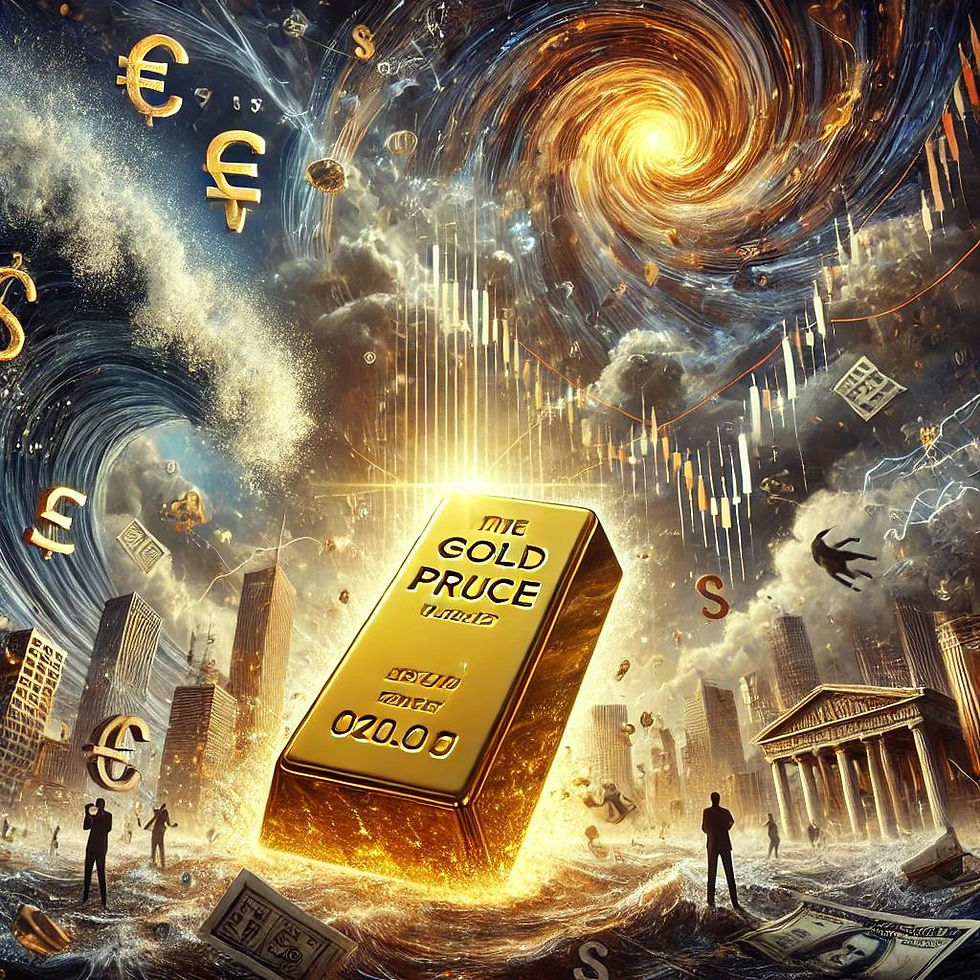Here's Why the Gold Price Responds to Uncertainty and Chaos
- johnwick

- Dec 6, 2024
- 3 min read

Gold thrives in times of uncertainty, and today’s chaotic world is no exception. Historically, gold has served as a sanctuary, offering stability when paper currencies and volatile markets fail. But what happens when even the most trusted safe havens—like the United States—begin to falter? Rising geopolitical tensions, economic mismanagement, and social unrest are shaking investor confidence, and gold is responding.
Let’s explore why gold reacts to uncertainty, what this means for investors, and why this precious metal remains a critical part of any strategy in an increasingly unstable world.
Gold: The Time-Tested Hedge
For decades, the United States has been the go-to haven for global capital during times of crisis. Its stability, rule of law, and economic dominance have made it the ultimate safety net. However, these foundations are now showing cracks. Geopolitical uncertainty, fiscal irresponsibility, and social unrest are eroding confidence in traditional sanctuaries.
Gold, by contrast, offers a tangible, unchanging value that no amount of monetary policy can dilute. Unlike fiat currencies, gold cannot be printed—it must be mined. Its finite supply and intrinsic value make it the ultimate hedge against chaos and uncertainty.
Early Stages of a Bull Market
Despite gold’s strong performance and recent surges to all-time highs, participation from both institutions and retail investors remains lackluster. Adam Taggart, a veteran gold dealer, highlights a surprising trend: instead of buyers rushing in, many are still selling. These sellers typically fall into three categories:
Investors who bought in 2012 and have waited to break even.
“Loose-hand” investors taking short-term profits.
People liquidating gold to cover immediate financial needs.
This lack of widespread enthusiasm suggests the gold bull market is still in its early stages. Historically, retail participation doesn’t peak until the final innings of a bull market, leaving significant upside potential for long-term investors.
Rising Costs and Tight Energy Supply
Gold’s rising price isn’t happening in isolation. Energy markets, particularly offshore oil and gas services, also reflect growing uncertainty. Supply chain bottlenecks, rising development costs, and tight capacity are driving up prices.
According to Rystad Energy, offshore oil and gas project costs are expected to rise 9% by 2026, with similar pressures impacting gold mining and refining. As energy costs rise, so too does the cost of extracting and processing gold, creating additional upward pressure on its price.
Gold vs. Other Assets
Gold’s performance compared to traditional stock market indices like the Dow Jones and S&P 500 paints an interesting picture. Much of the nominal gains in equities since 2003 can be attributed to money printing and inflation rather than real growth. Adjusted for these factors, gold has outperformed many traditional assets over the long term.
This isn’t just an equity bubble—it’s a debt-fueled illusion. Governments and central banks are addicted to printing money to sustain markets, and gold stands as a stark contrast. It’s not just an investment; it’s insurance against systemic collapse.
Lessons from the Laffer Curve
High taxes and inefficient government spending aren’t just economic issues—they’re red flags for investors. The UK’s struggles with fiscal mismanagement have driven businesses and wealth creators away, while Dubai’s business-friendly policies have resulted in a 21% budget surplus.
This serves as a warning: governments that overreach risk eroding social trust and stifling innovation. For investors, gold becomes an essential hedge against the consequences of poor policy and economic mismanagement.
The Big Picture
We’re living through one of the most significant financial transitions in history. Gold’s rising price reflects deeper systemic issues: spiraling debt, energy constraints, and geopolitical instability. These factors create the perfect storm for gold to shine.
It’s not just about fear or speculation; gold is a response to the cracks forming in the global financial system. For investors, the message is clear: the time to act is now.
Final Thoughts
As uncertainty mounts, gold offers a safe haven for preserving and growing wealth. Whether you’re a seasoned investor or new to precious metals, the writing is on the wall: gold moves with uncertainty, and chaos is here to stay.
If you’re looking to protect your wealth in this environment, now is the time to consider gold—not just as an investment, but as essential insurance against a volatile future.



Comments